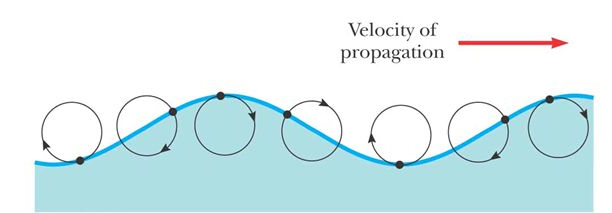Waves come in many shapes and forms. While all waves share some basic characteristic properties and behaviors, some waves can be distinguished from others based on certain observable and non-observable characteristics. It is common to categorize waves based on these distinguishing characteristics. Specific wave types can belong to one or more categories.
One way to categorize waves is on the basis of the types of mediums through which they are able to travel:
- Mechanical waves
- require a medium through which to propagate -mechanical waves depend upon particle interaction as a means for transporting their energy; they are unable to travel through regions of space devoid of particles (a vacuum) – the medium must possess:
- elasticity: the ability of a body to resist a distorting influence and return to its original size and shape when that influence or force is removed; objects will deform when adequate loads are applied to them – if the material is elastic, the object will return to its initial shape and size after removal of the load.
- inertia: the resistance of any physical object to any change in its speed or direction of motion – objects tend to keep moving in a straight line and at a constant speed, when no forces act upon them.
- can further be distinguished by the phases of matter through which they can travel:
- transverse waves: can travel through solids
- longitudinal waves: can travel through solids, liquids and gas
- waves move through mediums by vibrating the molecules in the matter
- the molecules in solids are packed very tightly, liquids are not packed as tightly, and gases are very loosely packed – this enables waves to travel much faster through a solid than a gas.
- Electromagnetic waves
- do not require a medium through which to propagate – can travel both through matter and through an empty space (a vacuum).
- Matter waves
- a concept central to the realm of quantum physics, based on the dual nature of matter: its ability to exist both as a particle and a wave
Another way to categorize waves is on the basis of the direction of movement of the individual particles of the medium relative to the direction that the waves travel (motion of energy):
- Longitudinal waves
- the movement of the particles is parallel to the motion of energy

- Transverse waves
- the movement of the particles is at right angles or perpendicular to the motion of energy

- Surface waves
- when a wave strikes an interface between two materials with differing physical properties, the wave motion “bends” into a circular pattern or orbit
- unlike longitudinal and transverse waves, wherein all the particles in the the medium travel in parallel and perpendicular directions (respectively) relative to the direction of energy transport – in a surface wave, it is only the particles at the surface of the medium that undergo the orbital motion


